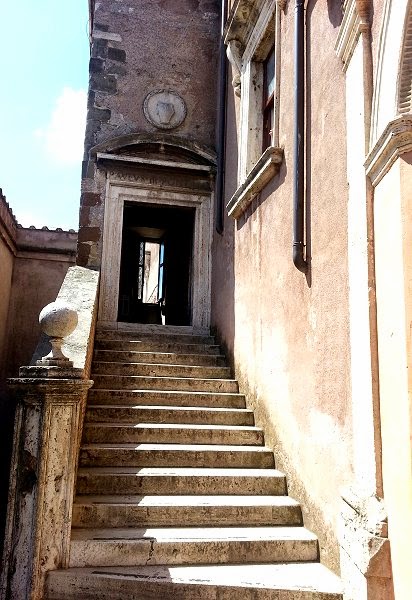Originally the mausoleum was a decorated cylinder, surrounded with a garden and a golden quadriga ( a two-wheeld chariot ... ) on top. Hadrian's ashes were placed here a year after his death in 138 AD, together with those of his wife Sabina, and his first adopted son, Lucius Aelius, who also died in 138 AD. Following this, the remains of succeeding emperors were also placed here, the last recorded deposition being Caracalla in 217 AD. The urns containing these ashes were probably placed in what is now known as the Treasury room deep within the building.
Ponte Sant'Angelo
Angel with the Nail
Girolamo Lucenti
Angel with the Garment and Dice
Paolo Naldini
Angel with the Crown of Thorns
Paolo Naldini
Angel with the Sudarium ( handkerchief )
Cosimo Fancelli
Angel with the Whips
Lazzaro Morelli
Angel with the Column ( Throne )
Antonio Raggi
Angel with the Superscription
Giulio Cartari
Angel with the Cross
Ercole Ferrata
Angel with the Sponge and Vinegar
Antonio Giorgetti
Angel with the Lance
Domenico Guidi
Much of the tomb contents and decorations have been lost since the building's conversion to a military fortress in 401. The urns and ashes were scattered by looters during the sacking of Rome in 410, and the original decorative bronze and stone statuary were thrown down upon the attacking Goths when they besieged Rome in 537. An unusual survivor, however, is the capstone of a funerary urn ( probably that of Hadrian ), which is now in Saint Peter’s Basilica just down the road.
2nd century portrait of Hadrian
Inside the Castel walls ...
- Giorgio Vasari writes: ... " ... in order to build churches for the use of the Christians, not only were the most honoured temples of the idols [pagan Roman gods] destroyed, but in order to ennoble and decorate Saint Peter's with more ornaments than it then possessed, they took away the stone columns from the tomb of Hadrian, as well as many other things which we now see in ruins ..."
Originally the Castel was surrounded by a sloping man-made hill planted with Cyprus Pines and ornamental gardens. The soil and gardens were removed several centuries ago exposing the rugged foundations of the Castel.
the Castel foundations ...
Once inside the ramparts it was in through the atrium and up several metres of winding paved ramp through the core of the structure
... finally opening out onto a courtyard and entry to the National Museum ( ... no photos allowed - sorry ... ). The museum exhibits archaeological finds from the excavations near the Monument, plus several important works of art and military equipment.
Then it was more stairs leading upwards and finally opening out into the Papal apartments ...
The popes converted the structure into a castle, beginning in the 14th century; Pope Nicholas III connected the castle to Saint Peter’s Basilica by a covered fortified corridor. The fortress was the refuge of Pope Clement VII from the siege of Charles V during the Sack of Rome ( 1527 ). Leo X built a chapel and later Paul III built a rich apartment, to ensure that in any future siege the Pope had an appropriate place to stay.
Frescoes painted by Peter John Bonaccorsi - 1545
The final staircase leading to the roof-top deck
with Rome and the Tiber sprawling below ...
Saint Peter's Basilica
Another view of Ponte Sant'Angelo
In 1536 Raffaello da Montelupo created a marble statue of Saint Michael holding his sword after the 590 plague ( as described below ) to surmount the Castel. This statue was replaced by a bronze statue of the same subject, executed by the Flemish sculptor Peter Anton von Verschaffeit, in 1753. Verschaffelt's is still in place and Montelupo's can be seen in an open court in the interior of the Castle.
The original Saint Michael by Raffaello da Montelupo
its marble winds sadly lost and replaced with metal copies
Legend holds that the Archangel Michael appeared atop the mausoleum, sheathing his sword as a sign of the end of the plague of 590, thus lending the castle its present name. A less charitable yet more apt elaboration of the legend, given the militant nature of this archangel, was heard by the 15th-century traveler who saw an angel statue on the castle roof. He recounts that during a prolonged season of the plague, Pope Gregory I heard that the populace, even Christians, had begun revering a pagan idol at the church of Santa Agata in Suburra. A vision urged the Pope to lead a procession to the church. Upon arriving, the idol miraculously fell apart with a clap of thunder. Returning to St Peter's by the Aelian Bridge, the Pope had another vision of an angel atop the castle, wiping the blood from his sword on his mantle, and then sheathing it. While the Pope interpreted this as a sign that God was appeased, this did not prevent Gregory from destroying more sites of pagan worship throughout Rome.
The Archangel Saint Michael
- Peter Anton von Verschaffeit
Then it was down more flights of stairs and back out into the real world of Rome 2014.




































No comments:
Post a Comment
Note: Only a member of this blog may post a comment.